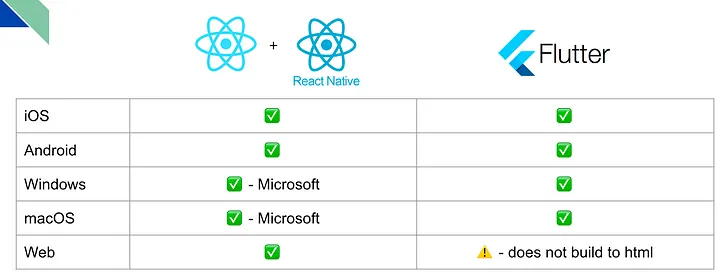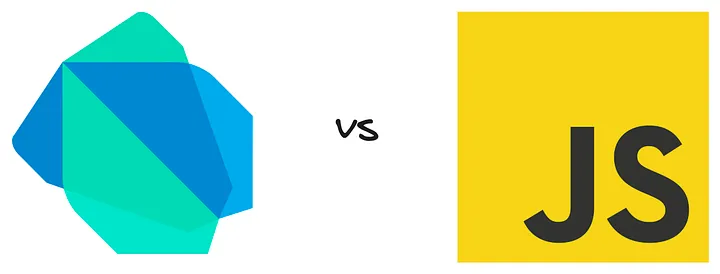Flutter vs React Native - A guide from every experience level
- Authors

- Name
- Justin Kek
- @justin_kek
- Developer @ Theodo Group
- Published on

Which cross-platform framework should you choose as a junior dev, senior dev and CTO?
Introduction
If you’re reading this article you’ve probably decided to use a cross-platform framework over native development. Cross-platform frameworks allow you to deploy to multiple platforms from a single codebase, which has two main benefits:
- Cost and time savings
- Consistency in UX/UI
The two main contenders in the cross-platform framework space are Flutter and React Native, and in the following sections, we will discuss the tradeoffs of each framework from the perspective of a junior dev, senior dev and a CTO.
Just two things to note before we begin:
- Each perspective will consist of two parts: a TLDR with the main takeaways, and a detailed explanation of the tradeoffs contained within a separate article. This will allow you to get a quick summary of the two frameworks, and dive deeper into the details if you need to.
- The sections are written in a way that builds on each other, so if you are a junior dev, I recommend that you read through the sections for senior devs and CTOs as well. This will help you understand the higher-level implications of each framework, and how it will affect your career growth in the long run. Similarly, if you are a CTO choosing Flutter or React Native to develop your company’s product, I strongly recommend that you read through the sections for junior devs and senior devs as well. This will help you understand the lower-level implications of each framework, and how it will affect the quality and speed at which your product will be developed.
Now that we’ve gotten that out of the way, let’s dive in with a quick overview!
An overview of Flutter and React Native
React Native is an open-source mobile application framework created by Facebook. It was released in March 2015 and has become one of the most popular frameworks for mobile app development.
Flutter is an open-source UI software development kit created by Google. It was first introduced in May 2017 and has quickly gained popularity in the developer community.
Platforms supported by Flutter and React Native
Both frameworks allow you to deploy to iOS, Android, Web, MacOS and Windows, but there are platform-specific considerations that should be noted:
Flutter supports all platforms out of the box, but there is a key limitation with deploying to the web — Flutter does not build to HTML.
React Native on the other hand, supports all platforms, but you’ll need to use Microsoft’s (third-party) packages to build to Windows and macOS, which adds complexity to your toolchain.
Languages used by Flutter and React Native
Flutter uses the Dart programming language, which is also developed by Google. Dart has sound typing, which is a type system that guarantees that the type of a variable is known at compile time. This means that runtime type errors are impossible, which can help to reduce the number of bugs in your codebase.
React Native uses JavaScript, which has a rich history in web development and extensive online resources. It can be combined with TypeScript to provide static typing, but runtime type errors are still possible.
UI components used by Flutter and React Native
Flutter comes with a rich set of pre-designed widgets that follow specific design languages, such as Material Design and Cupertino. These widgets help in creating visually appealing and “natively behaving” apps for both Android and iOS platforms. However, you can also create custom design systems with highly composable widgets.
React Native uses native components as building blocks, and as a result, provides the look, feel, and performance of native applications.
Now that we’ve gotten a quick overview of Flutter and React Native, let’s dive into the tradeoffs of each framework from the perspective of a junior dev, senior dev and a CTO.
Flutter vs React Native as a Junior Dev
As a junior dev, your main responsibility is usually to bring value to users with the code you create. You may be inexperienced with the tools and frameworks, so the questions on your mind may be:
- Which framework can provide the best developer experience (DevX) so that I can deliver value to users as quickly as possible?
- Which framework will help me grow the most as a developer?
- Which framework will help me get a job in the future?
The TLDR to these questions are:
- Flutter excels at out-of-the-box DevX and a simple toolchain.
- React Native excels at the amount of resources and job opportunities available.
- Both frameworks will help you grow as a developer but in different ways. For me,
- I've spent more time learning about OOP and app architecture, in Dart/Flutter. This is because Flutter saved a lot of my dev time with its simplified toolchain, allowing me to spend more time on design patterns and codebase structure.
- In JS/React Native, I've spent more time learning about the JS ecosystem and how to debug complicated toolchains - something that is typically abstracted away in Flutter. This became a framework-agnostic skill for me but was frustrating to learn as a junior dev.
You can dive into the details in the following article: Flutter vs React Native: As a Junior Dev
Flutter vs React Native as a Senior Dev
As a senior dev, factors such as developer experience may become less important since you have acquired the skills, knowledge and tools to work around DevX hurdles. Instead, the questions you may be concerned about are:
- How can the framework help my team work faster and smarter?
- Which framework will have more job stability so that I can support my dependents?
- Which framework has a higher skill ceiling so that I can continue to grow as a developer?
- Which framework is more likely to be used in the future? -->
The TLDR to these questions are:
- Flutter excels at dependency injection, E2E testing, and UI standardisation, which will help your team work more efficiently.
- React Native excels in the number of packages available, which means someone else has probably already solved the problem you are facing, saving dev time.
You can dive into the details in the following article: Flutter vs React Native: As a Senior Dev
Flutter vs React Native as a CTO
As a CTO, you are responsible for the technical direction of the company, and you need to make decisions that will help the company achieve its business goals. Some questions you may be concerned about are:
- Does the framework have the features we need to achieve the business goal?
- What can each framework do to help us achieve the goal with the least amount of resources?
The key advantages of each framework are:
- Flutter excels in complex UI and UI standardisation. This is beneficial if complex animations are a key requirement for your app, and UI consistency is important to your brand image. Also, Flutter’s UI standardisation can help to reduce the number of bugs and resources spent on fixing platform and device-dependent bugs.
- React Native excels in the amount of resources, web support and OTA updates. Again, the fact that someone else has already solved your problem means that you can save dev time and resources. Additionally, web support means that you can deploy to the web with SEO, which is a key advantage over Flutter. Finally, OTA updates allow you to push updates to your users without going through the app store review process, which can be a huge time saver.
You can dive into the details in the following article: Flutter vs React Native: As a CTO
Use Cases
In this section, we will go through a set of potential scenarios and my recommendations. The previous sections should help to trigger bells in your head as we go through each scenario and list down questions which need to be considered.
I want to build an app for mobile, desktop and the web with SEO (e.g. Medium, Reddit)
If you are looking to build an app like Medium, where a large portion of the content in the app needs to be crawlable, React Native may be the more attractive choice.
The options on the table are:
- React Native for desktop and mobile, NextJS for web
- React Native for desktop, mobile and web.
- Flutter for mobile and desktop, NextJS for web
React Native + NextJS: One of the best ways you can improve SEO is to use a server-side rendering framework like NextJS alongside your React Native app. React Native components can be imported directly into NextJS, allowing you to build universal apps for functional and design consistency. See reactnative-nextjs-template or luna for examples.
React Native only: Using React Native for all platforms will allow you to have one less framework in your stack, but you will need to find a way to make your app crawlable on the web.
Flutter + NextJS: This will allow you to adhere to SEO best practices while reaping the benefits of Flutter. However, this would mean that you would need a team capable of developing in both frameworks.
Questions you should ask yourself before deciding:
- How much code needs to be shared between mobile/desktop and web?
- What needs to be SEOed, and to what extent?
- What are the skill sets of my team?
- What functionalities will the app require, and are there existing libraries for it?
- How complex is the application I am building?
I want to build an app for mobile, desktop and web (e.g. Spotify)
If you are looking to build an app like Spotify, where one of your success criteria is to maintain consistent UI and UX across platforms and SEO is not as important, then Flutter may be the more attractive choice.
The options on the table are:
- Flutter for mobile, desktop and web apps, NextJS for website
- React Native for mobile, desktop and web, NextJS for website
Flutter + NextJS: Using Flutter for the application experience, and NextJS for the landing page allows you to avoid all the platform and device-specific bugs associated with using native components in React Native. Developing the website in NextJS keeps it SEO-friendly while still allowing you to embed the Flutter web app as an SPA if need be.
React Native + NextJS: Using React Native allows you to share design elements with the Next website, saving on design costs.
Questions you should ask yourself before deciding:
- How much of the design elements can be shared between the React Native app and the NextJS website, and how much resources will that save?
- What are the skill sets of my team?
- What functionalities will the app require, and are there existing libraries for it?
I want to build an app for mobile, and I want native behaviour (e.g. native scrolling, fancy iOS components)
If you are looking to build an app where your target users are sensitive to non-native behaviour, e.g. scrolling, then React Native may be the more attractive choice.
The options on the table are:
- React Native for iOS and Android
- Flutter for iOS and Android
Using React Native will allow you to tap into the look and behaviour of native components in iOS and Android. Additionally, iOS components are known to be fancy and performant, which is a bonus.
While using Flutter will not give you the same native look and feel on iOS, it can bring significant advantages to Android, because there are quite a few Android variants where native UI elements can sometimes behave unpredictably. In such cases, Flutter provides a level of consistency that might be hard to achieve with React Native or even native Android development.
Questions you should ask yourself before deciding:
- How many Android platforms am I targeting, and how complex is the UI? Will the benefits of using native components in Android outweigh the visual bugs that may arise?
- What are the skill sets of my team?
- What functionalities will the app require, and are there existing libraries for it?
Conclusion
There is no best framework, only tradeoffs which you need to balance for your use case. This guide will likely evolve throughout the upcoming months, so stay tuned! If you have any further questions, feel free to reach out!
Big shoutout to:
- Mo Javad, Head of Mobile @ Theodo UK, for his recommendations on how I should structure this article from different perspectives.
- Guillaume Diallo Boisgard for sharing his experience as Head of Flutter @ BAM
- Matthieu Perenelle for sharing his insights from becoming a Flutter developer after working with React Native @ BAM
Disclosure: I’ve tried to write this article as objectively as I can, but I am not omniscient nor completely unbiased (I started my dev journey with Flutter). Please leave a comment if you feel like this article is missing key points of debate so that we can have more insightful discussions to grow both communities and potentially shape the frameworks into their niche!

